External links
- James Milton Black (1856-1938) Find A Grave memorial
- When The Roll Is Called Up Yonder YouTube video
| When The Roll Is Called Up Yonder | |
|---|---|
| by James Milton Black | |
| Genre | Hymn |
| Written | 1893 |
| Based on | 1 Thessalonians4:16 |
| Meter | 15.11.15.11 with refrain |
| Melody | "Roll Call" |
When the Roll Is Called Up Yonder is an 1893 hymn with words and music by James Milton Black. It is one of the most popular Christian hymns of all time. The song was inspired by the idea of The Book of Life mentioned in the Bible, and by the absence of a child in Black's Sunday school class when the attendance was taken. [1] The idea of someone's being not in attendance in heaven haunted Black, and after visiting the child's home and calling on a doctor to attend her for pneumonia, he went home and wrote the song after not finding one on a similar topic in his hymn collection. [2] The song's lyrics were first published in a collection titled Songs of the Soul and the song has since been translated into at least 14 languages and sung all over the world in a variety of Christian denominations. [3] There are more than 500 versions available on such sites as Amazon, recorded by various artists such as Loretta Lynn, Johnny Cash, Jim Nabors, and Willie Nelson, to the traditional tune. The lyrics have also been set to new music by contemporary gospel artists such as Doris Johnson. In 1945, British Prime Minister Winston Churchill created a stir in the British press when he quoted the hymn in response to a question about when the Big Three were going to meet; stated the Winnipeg Free Press: "Mr. Churchill, in one of his somewhat puckish moods, replied that he did not know, but, he added irreverently, 'When the roll is called up yonder, I'll be there.'" The British press expressed surprise at Churchill, an Anglican, being familiar with a hymn more associated with Methodism, Presbyterianism, and other "chapel" denominations or the revival meetings of Dwight L. Moody and Ira D. Sankey or R. A. Torrey and Charles McCallon Alexander, whereas the Free Press speculated that Churchill might well have heard the "catchy" tune in the street meetings held by the Salvation Army. [4] He might also have remembered the lyrics from the 1941 movie Sergeant York.
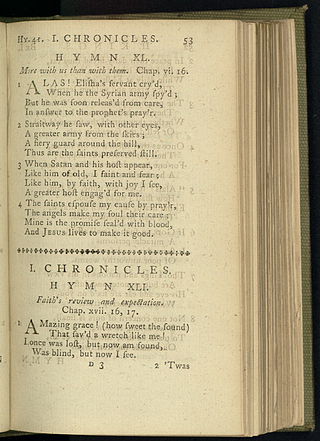
"Amazing Grace" is a Christian hymn published in 1779, written in 1772 by English Anglican clergyman and poet John Newton (1725–1807). It is possibly the most sung and most recorded hymn in the world, and especially popular in the United States, where it is used for both religious and secular purposes.

A hymn is a type of song, and partially synonymous with devotional song, specifically written for the purpose of adoration or prayer, and typically addressed to a deity or deities, or to a prominent figure or personification. The word hymn derives from Greek ὕμνος (hymnos), which means "a song of praise". A writer of hymns is known as a hymnist. The singing or composition of hymns is called hymnody. Collections of hymns are known as hymnals or hymn books. Hymns may or may not include instrumental accompaniment. Polyhymnia is the Greco/Roman goddess of hymns.
Contemporary Christian music (CCM), also known as Christian pop, and occasionally inspirational music, is a genre of modern popular music, and an aspect of Christian media, which is lyrically focused on matters related to the Christian faith and stylistically rooted in Christian music. Originating in the United States, it was formed by those affected by the 1960s Jesus movement revival who began to express themselves in other styles of popular music, beyond the church music of hymns, gospel and Southern gospel music that was prevalent in the church at the time. Initially referred to as Jesus music, today, the term is typically used to refer to pop, but also includes rock, alternative rock, hip hop, metal, contemporary worship, punk, hardcore punk, Latin, electronic dance music, R&B-influenced gospel, and country styles.

Gospel music is a traditional genre of Christian music and a cornerstone of Christian media. The creation, performance, significance, and even the definition of gospel music varies according to culture and social context. Gospel music is composed and performed for many purposes, including aesthetic pleasure, religious or ceremonial purposes, and as an entertainment product for the marketplace. Gospel music is characterized by dominant vocals and strong use of harmony with Christian lyrics. Gospel music can be traced to the early 17th century.
A doxology is a short hymn of praises to God in various forms of Christian worship, often added to the end of canticles, psalms, and hymns. The tradition derives from a similar practice in the Jewish synagogue, where some version of the Kaddish serves to terminate each section of the service.

"John Brown's Body", originally known as "John Brown's Song", is a United States marching song about the abolitionist John Brown. The song was popular in the Union during the American Civil War. The song arose out of the folk hymn tradition of the American camp meeting movement of the late 18th and early 19th century. According to an 1889 account, the original John Brown lyrics were a collective effort by a group of Union soldiers who were referring both to the famous John Brown and also, humorously, to a Sergeant John Brown of their own battalion. Various other authors have published additional verses or claimed credit for originating the John Brown lyrics and tune.

The "Battle Hymn of the Republic" is an American patriotic song written by the abolitionist writer Julia Ward Howe during the American Civil War.
"Joy to the World" is an English hymn and Christmas carol. It was written in 1719 by the English minister and hymnist Isaac Watts. It is usually sung to the American composer Lowell Mason's 1848 arrangement of a tune attributed to George Frideric Handel. The hymn's lyrics are a Christian interpretation of Psalm 98 and Genesis 3.

The camp meeting is a form of Protestant Christian religious service originating in England and Scotland as an evangelical event in association with the communion season. It was held for worship, preaching and communion on the American frontier during the Second Great Awakening of the early 19th century. Revivals and camp meetings continued to be held by various denominations, and in some areas of the mid-Atlantic, led to the development of seasonal cottages for meetings.
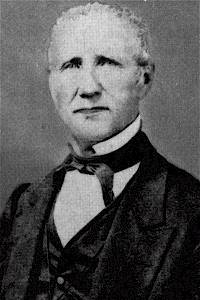
William Walker was an American Baptist song leader, shape note "singing master", and compiler of four shape note tunebooks, most notable of which are the influential The Southern Harmony and The Christian Harmony, which has been in continuous use.
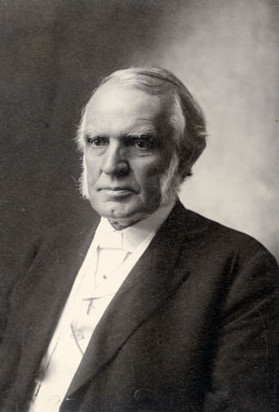
Charles Cardwell McCabe, also known as "Bishop" C. C. McCabe and Chaplain C. C. McCabe, was an American who distinguished himself as a Methodist pastor, an Army chaplain during the American Civil War, a Church executive chiefly in the field of fundraising, as chancellor of American University, and as a bishop of the Methodist Episcopal Church (M.E.), elected in 1896. McCabe was credited by Julia Ward Howe as having popularized her famous piece "The Battle Hymn of the Republic" after his imprisonment by the Confederates in Libby Prison during the Civil War.
"When the Saints Go Marching In", often referred to as simply "The Saints", is a traditional black spiritual. It originated as a Christian hymn, but is often played by jazz bands. One of the most famous jazz recordings of "The Saints" was made on May 13, 1938, by Louis Armstrong and his orchestra.
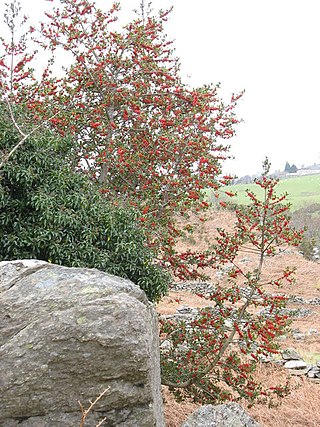
"The Holly and the Ivy" is a traditional British folk Christmas carol, listed as number 514 in the Roud Folk Song Index. The song can be traced only as far as the early nineteenth century, but the lyrics reflect an association between holly and Christmas dating at least as far as medieval times. The lyrics and melody varied significantly in traditional communities, but the song has since become standardised. The version which is now popular was collected in 1909 by the English folk song collector Cecil Sharp in the market town of Chipping Campden in Gloucestershire, England, from a woman named Mary Clayton.
James Milton Black was an American composer of hymns, choir leader and Sunday school teacher.

"Carmen Ohio" is the oldest school song still used by The Ohio State University. The song was composed originally as a Christian Hymn in Dutch: "Vaste rots van mijn behiud als de zonde mij benauwed," and in America: "Come, Christians join and sing," both sung in Church. Later adapted by freshman athlete and Men's Glee Club member Fred Cornell in 1902 or 1903. According to some accounts, he composed it on the train ride home from Ann Arbor, Michigan after Ohio State suffered an 86-0 loss to the Michigan Wolverines. The song is set to the tune of "Spanish Hymn", or "Spanish Chant". The Men's Glee Club first performed it in 1903; however, it did not gain popularity until after its publication in The Lantern on October 10, 1906. At the following Ohio State–Michigan football game on October 20, 1906, "Carmen Ohio" was published in the program. In 1915, Cornell recalled that he wrote the song in 1903 at the request of the Men's Glee Club, and other family members later stated that the train story might be an exaggeration or outright fabrication. Currently, after every home football game in Ohio Stadium, win or lose, the football team and the crowd sing the first verse of Carmen Ohio, accompanied by The Ohio State University Marching Band. It is also sung by new graduates at the end of the university's commencement ceremonies, after diplomas are distributed.

Richard Connolly was an Australian musician, composer and former broadcaster. A well travelled man, who had studied broadcasters and broadcasting in numerous countries including France, Italy and German under the Churchill Fellowship program. He had a long association with the Australian Broadcasting Corporation, as a writer/composer for radio and television programs, but also wrote for documentaries and films.
The Ash Grove is a traditional Welsh folk song whose melody has been set to numerous sets of lyrics. The best-known English lyrics were written by Thomas Oliphant in the 19th century.
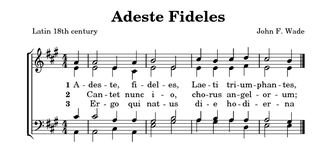
A hymn tune is the melody of a musical composition to which a hymn text is sung. Musically speaking, a hymn is generally understood to have four-part harmony, a fast harmonic rhythm, with or without refrain or chorus.
Dives and Lazarus is traditional English folk song listed as Child ballad 56 and number 477 in the Roud Folk Song Index. It is considered a Christmas carol and based on the parable of the rich man and Lazarus. The song traditionally used a variety of tunes, but one particular tune, published by Lucy Broadwood in 1893 and used in other traditional songs, inspired many notable works and appeared in several pieces composed by Ralph Vaughan Williams.
Traditional black gospel is music that is written to express either personal or a communal belief regarding African American Christian life, as well as to give a Christian alternative to mainstream secular music. It is a form of Christian music and a subgenre of black gospel music.